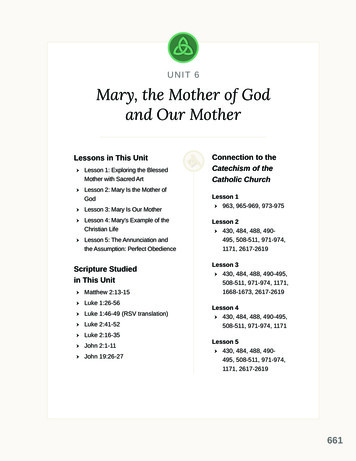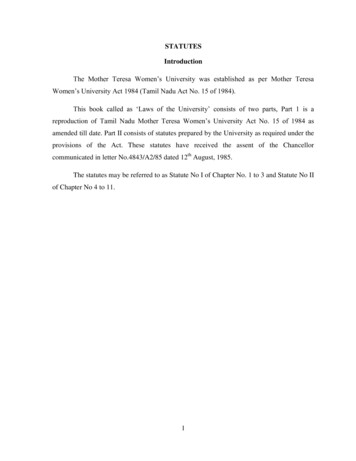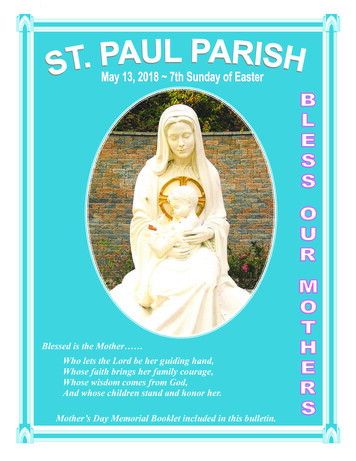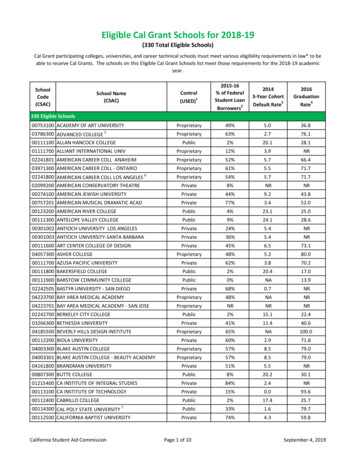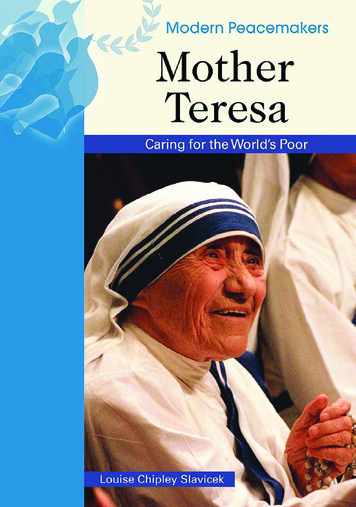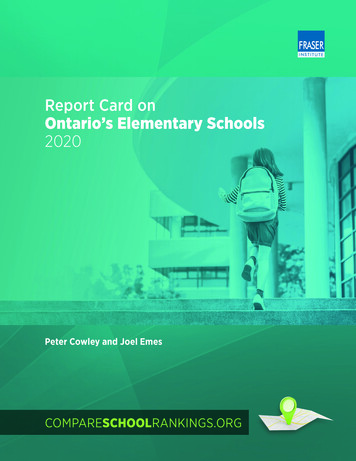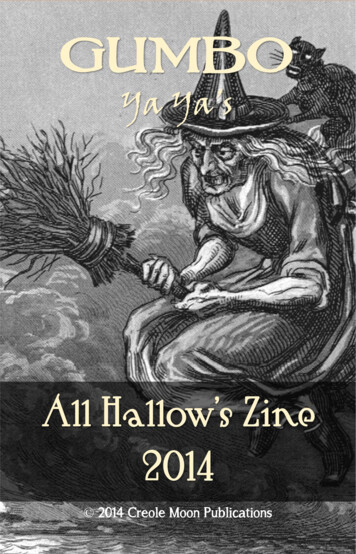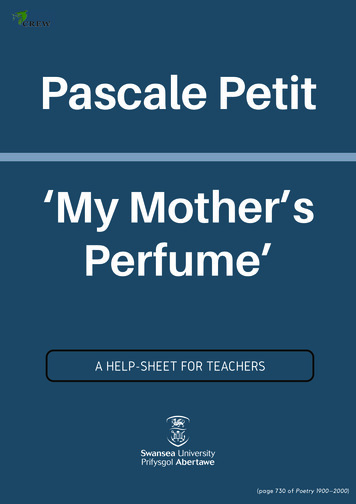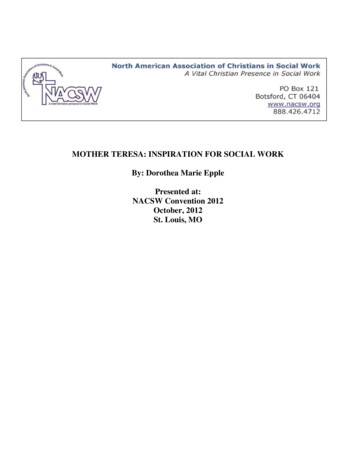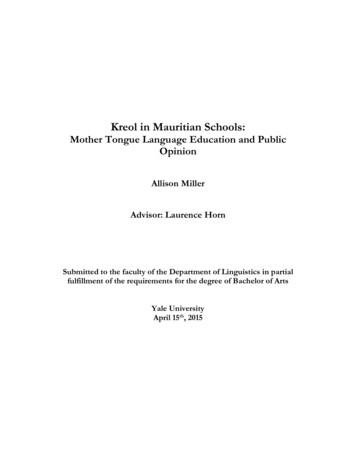
Transcription
Kreol in Mauritian Schools:Mother Tongue Language Education and PublicOpinionAllison MillerAdvisor: Laurence HornSubmitted to the faculty of the Department of Linguistics in partialfulfillment of the requirements for the degree of Bachelor of ArtsYale UniversityApril 15th, 2015
2AbstractSince before independence in 1968, Mauritian language planning has favored thecolonial languages of English and French over Mauritian Creole, or Kreol, in the educationsystem, despite Kreol’s status as the native language of the vast majority of Mauritians.Mauritians have disapproved of the use of Kreol in the education system historically, but inthe past 5 years, Kreol has expanded its scope of use in Mauritian classrooms. This studyuses survey data from Mauritian citizens in 2015 to assess whether opinions towards Kreoland its use in the Mauritian education system have changed, and if so, why.In this essay, I first detail the current linguistic situation in Mauritius and the state ofthe education system and language education policy there, including recent pro-Kreol shifts.I then use survey data received from native Mauritian participants to assess attitudes towardKreol and its use in the education system, along with reasons for Mauritians’ support forKreol or lack thereof.My essay concludes by analyzing the broader context of thisMauritian case study, explicating the benefits of mother tongue language education beyondthe scope of Mauritius and comparing language education policy and its effects in othercreole-speaking, post-colonial nations in order to situate Mauritius within the greater,worldwide debate regarding multilingual educational programs.The case of Mauritiusprovides an example of a country that, with further understanding of the cognitive andacademic advantages of mother tongue language education, may be on the brink ofpromoting its national language in the education system to greater benefit Mauritianstudents.
Acknowledgements3I would like to firstly thank my advisor Larry Horn for his continued support andinsightful input throughout this project, along with previous instruction in courses thatoriginally influenced me to study sociolinguistics more closely. I also owe a debt of gratitudeto Professors Joe Errington and Jemima Anderson for their expertise and knowledge in thefield of sociolinguistics, from which I have greatly benefitted during my time at Yale. I alsowould like to especially thank DUS Raffaella Zanuttini for her mentorship throughout myundergraduate career and also for her ongoing encouragement in pursuing sociolinguistics asa field of study. Her constant support in both academic and personal endeavors and care forher students’ personal well being has made the Linguistics Department a comforting homebase throughout my four years here.I also have to thank my fellow majors for their feedback and guidance on this projectthroughout the entire year, which has helped to shape this project into what it is today.Your camaraderie and shared gains and pains throughout the year have made this process awholly enjoyable one, and I am glad to have spent it together.Last but not least, I am deeply grateful to all my Mauritian friends and contacts whohave helped immensely in this project, along with the numerous strangers who have takeninterest in it. It is truly a testament to the warm, friendly, hospitable, and selfless culture ofMauritians that I have experienced time and again on the island to see strangers,acquaintances, and friends put time and effort into helping me. I am proud, passionate, andthankful to be able to discuss a topic so close to my heart for my senior essay. I cannotthink of any culture, community, or people more deserving to devote my project to. Thisessay is dedicated to my Mauritian host family, friends, acquaintances, and students whohave constantly inspired me and, without whom, this essay would not exist.
Table of Contents41 Introduction . 62 Mauritius: History, Demography, and Language . 82.1 History . 82.2 Demography . 92.3 Language. 103 The Multilingual Education System . 123.1 Language Use and Planning in Mauritian Primary Schools . 123.2 Failure of the System and Language Examinations. 143.3 Kreol Instruction as a Solution in Language Planning . 154 Opposition and Support of Kreol: Public Opinion and Recent Policy . 194.1 Public Opposition to Kreol in the Education System . 194.2 Recent Pro-Kreol Changes . 205 Basis For Research . 215.1 Research Questions . 215.2 Hypotheses. 226 This Study: Methodology and Participants . 236.1 Survey Methods . 236.2 Survey Content . 256.3 Participants . 317 Results. 387.1 Language Backgrounds and Abilities . 387.2 Kreol: Agree or Disagree . 427.3 Kreol and Education: Open-Ended Responses . 488 Discussion . 518.1 Changing Opinions Since Rajah-Carrim 2007. 518.2 Lack of Previous Ethnic Associations . 548.3 Support for Other Previous Hypotheses . 568.4 One Unexpected but Most Important Reason . 598.5 A Note on Equality. 609 Broader Context: The Role of the Mother Tongue in Education . 619.1 Support for and Arguments against Mother Tongue Language Education . 619.2 Benefits of Mother Tongue Language Education: Case Studies . 629.3 Benefits of Mother Tongue Language Education: Theory . 6410 Cross-Country Comparisons . 6610.1 Seychelles: Creole as National Identity. 6710.2 Haiti: Simplified Diglossia with Larger Social Challenges . 6911 The Future of Kreol in Mauritius . 7311.1 Policy Recommendations . 73
512 References . 76
1Introduction6Effective language planning and policy requires a complicated system of cooperationbetween local and national governments, the citizens of a nation, and linguistic experts. Insituations of diverse multilingualism like those commonly found in African and post-colonialnations, successful language planning becomes even more difficult.In multilingualsituations, choices of language functions, prestige, and status are political and too often lackany linguistic basis. Difficult questions of national identity, benefits of the use of nativelanguages, and equality of linguistic representation abound in the act of language planning,and carrying out language policies on the ground can be even more difficult than theplanning itself. However, effective language planning and policy can be incredibly beneficialto ease of communication, language acquisition, and native linguistic rights to citizens ofmultilingual nations.Language planning often strategizes to achieve its goals through the medium ofpublic education. In this way, the government of a country is able to promote and evenrequire acquisition and formal competence in certain languages as a necessity to succeedwithin the public education system of a country. This focus on certain languages in theeducation system is generally coupled with granting official or higher status to somelanguages, effectively favoring these prestige languages in governmental, professional, andeducational spheres.An intriguing case study of language planning and policy, particularly in regards tothe language education system, can be found in the tiny, multilingual, and multiethnic islandnation of Mauritius, located 500 miles to the East of Madagascar.
7ReunionMauritiusFigure 1: Map of Mauritius and Southern AfricaThis creole-speaking, post-colonial nation has avoided much overt language planning in thelegislature of the country despite the multitude of languages used on the island; this isperhaps a reflection of the complexity of the sociolinguistic situation in Mauritius, caused bybroad multilingualism, triglossia, and ethnic associations of native languages. In addition tothe equivocation of the Mauritian government to create effective language policy, Mauritiusis also an interesting case study due to its citizens’ general lack of support for MauritianCreole, or Kreol Morisien, as an official language or as a language of instruction in schools inMauritius (Rajah-Carrim, 2007), despite Kreol’s widespread status as a first language of mostMauritians.Following recent pro-Kreol changes within the education system, this study willassess whether Mauritians’ opinions that Kreol is not a suitable language of instruction inprimary schools have persisted to 2015, continuing the negative opinions towards Kreol thatwere expressed in Rajah-Carrim’s interviews from 2002. It is also important to recognizeMauritians’ reasoning behind their opinions in order to change any unfounded beliefs
8regarding language and education in Mauritius, in an attempt to sway general Mauritiansupport for the most effective and beneficial language education policies for all Mauritians.2Mauritius: History, Demography, and Language2.1HistoryLike many African nations, Mauritius is home to a rich multilingual speechcommunity due to its history of colonialism, slave trade, and immigration for the entirety ofits history of human presence on the island. Mauritius is unique in that it was uninhabiteduntil colonization in the 17th century and has no indigenous population (EISA, 2009),meaning that there exists no language that is native to the island. This lack of any ethnicindigenous language and the consequent reliance on colonial languages has shaped theMauritian sociolinguistic situation to this day.Mauritius was first settled by the Dutch in 1598, though their settlement soon failedand little of their influence or effect on the island still exists, other than the extinction of theDodo bird. In 1715, Mauritius was claimed by the French, who had more success with theirsettlement, likely due to the importation of slaves from Africa who grew the agriculturebased economy of the island (EISA, 2009). The influence of the French colonization inMauritius is still present, with French both serving as one of the most widely-used languageson the island and also as a base for Mauritian Creole, or Kreol Morisien, which is the nativelanguage of most Mauritians.A century later in 1810, the British took over Mauritius as a colony after defeatingthe French in the Napoleonic Wars. Under Britain, slavery was abolished in the 1830’s andan indentured labor system was founded, under which thousands of Indian immigrantsarrived in Mauritius to work. Britain’s rule in Mauritius continued well into the 20th century
9until independence was gained in 1968; this long history with England has created ancontinuous presence of English in Mauritius, similar to the enduring usage of the Frenchlanguage.2.2DemographyThe history of colonial powers and immigration in Mauritius has given rise to adiverse make-up of Mauritian citizens, religiously, ethnically, and linguistically. Only a smallminority of white French or British descendants still live on the island, and the large majorityof Mauritians today are descendants of either African slaves or Indian indentured workers.According to the 2011 census data from Mauritius, 30.5% of the total population of 1.24million Mauritians is Christian, with the large majority being Roman Catholic. Another50.7% is Hindu, and 17.9% is Muslim, with the remaining population being Buddhist,Jewish, or not expressing their religion in the census data (Republic of Mauritius, 2011a).Total Mauritian Population byReligion (Census Data 2011)18%1%30%CatholicHinduMuslim51%No religionFigure 2: Total Mauritian Population by ReligionIn 1982, the former Mauritian census category of “ethnic membership” waseliminated, causing difficulty in the classification of ethnic groups (Eriksen, 1990). However,
10ethnicity maps roughly onto the religious groups expressed in the 2011 census, meaning thatethnic group can be extrapolated from religious identity. Catholics in Mauritius, primarilycalled Creoles, are descendants of slaves from Africa, while Hindu and Muslim Mauritiansshare ethnic Indian ancestry. The minority categories of Jews and Buddhists can be assumedto be Franco-Mauritians and Chinese immigrants respectively. Based on the 2011 censusdata regarding the respondents’ language of forefathers, nearly 1% of Mauritians stated thatthe language of their forefathers was Mandarin or another Chinese language, while 1.7%stated that this language was French or English, meaning that roughly 1% of Mauritians areof Chinese ethnicity and 1.7% are of European descent. Based on these percentages and thefact that ethnic groups of Indo-Mauritians and Creoles are composed of the same religiousgroups of Hindus, Muslims, and Catholics, we can assume that roughly 68% of Mauritiansare of Indian descent (both Muslims and Hindus), 30% are Creoles of African descent, andthe remaining 2% are White or Chinese.Though it is likely that a small mixed racepopulation exists on the island, inter-marriage between ethnic or religious groups is generallyuncommon (Eriksen, 1989), and therefore mixed race populations are not widely discussedor reported on. Therefore, any mixed race Mauritians likely still identify with one of thetraditional ethnic groups of Catholic Creoles, Indo-Mauritian Hindus, Indo-MauritianMuslims, Chinese, or Whites, rather than identifying with a wholly mixed race group.2.3LanguageMauritians use a variety of languages in their daily lives, including French, English,Kreol Morisien, and several other ancestral languages. Kreol is the language spoken at homeby 86.5% of Mauritians, while only 4.1% of Mauritians speak French at home and 0.5%speak English (Republic of Mauritius, 2011a). Some Indo-Mauritians also speak variousancestral Indian languages at home. These ancestral languages are heritage languages, which
11have been passed down through generations, from the original Indian immigrants to theisland to Indo-Mauritians present there today. Bhojpuri is the most common ancestralIndian language with 5.3% of Mauritians claiming it as the language they use at home.Additionally, out of over 1.2 million Mauritians, Tamil and Telugu each have over 1,000native speakers; Bengali is the maternal language of approximately 7,000 Mauritians whileHindi has roughly 8,500 native speakers in Mauritius (Republic of Mauritius, 2011a).Languages Spoken at Home byMauritiansKreolFrenchEnglishBhojpuriOther Ancestral IndianLanguages (Bengali, Hindi,Tamil, Telugu, etc)Figure 3: Pie chart of language spoken at home by MauritiansLanguage planning and policy in Mauritius is generally fraught with uncertainty. TheRepublic does not legally recognize any language as either official or national. Despite thisequivocation in language policy on the part of the Mauritian government, the Republic doesfavor the colonial language of English in practice. The Mauritian constitution states that“the official language of the [National] Assembly shall be English but any member may
12address the chair in French” (The National Assembly of Mauritius), which reflects thegovernment’s bias towards the two colonial languages over the native language of Kreol.Language use and attitudes on the island outside of official context mimic thispartiality towards French and English. While Kreol is the most widely spoken language, it isgenerally reserved for private or informal contexts, such as in the home or with friends,while French and English are used in more formal situations, as with a figure of authoritysuch as an employer or professor or in public discourse and media (Eriksen, 1990). Kreol isalso generally perceived as a less prestigious language and possesses a lower standing in thehierarchy of language status in Mauritius (Eriksen, 1990: 11).This use of certain languages or varieties in prestigious domains and others in lowerstatus domains by multilingual speakers is certainly not unique to Mauritius. This division oflanguage functions according to prestige and status is referred to as diglossia (Ferguson,1959), in which the H or high language is used in prestigious domains, such as literacy,professional contexts, or public speaking, while the L or low variety is found in moreinformal or relaxed settings. This theory of diglossia generally involves only two languages,one high and one low; however, in the case of Mauritius, this simplistic delineation ofmultilingualism is complicated by the use of both French and English as H languages and bythe existence of various ancestral Indian languages among the Indian population on theisland.3The Multilingual Education System3.1Language Use and Planning in Mauritian Primary SchoolsThe lack of clarity in general language planning in Mauritius also extends to theeducation system. Again, policy regarding languages of instruction is minimal, with the most
13recent decree on this topic coming from 1957, eleven years before Mauritius became anindependent nation. The Education Ordinance of 1957 states:In the lower classes of Government and aided primary schools up to and including Standard III, anyone language may be employed as the language of instruction, being a language which in the opinionof the Minister is most suitable for the pupils.In Standards IV, V, and VI of the Government and aided primary schools the medium ofinstruction shall be English, and conversation between teacher and pupils shall be carried on inEnglish; provided that lessons in any other language taught in the school shall be carried on throughthe medium of that instruction (Sonck, 2005).In addition to the fact that this policy was established over 50 years ago, when Mauritius wasstill under British rule, the policy itself does not provide any exactitude concerning thelanguage of instruction for the first three years of primary schooling.This vagueness leads to confusion and wide variation in languages of instructionacross the country. In most Mauritian classrooms, a combination of Kreol, French, andEnglish are all used, though for different purposes (Sonck, 2005). Both English and Frenchare subjects of study for Mauritian students, while Kreol is not; this results in mosttextbooks and written sources being English or French based. While English is the goal forthe medium of instruction, French, which is much closer to the native Kreol and also muchmore widely spoken among the Mauritian population (Rajah-Carrim, 2007: 52), is also usedin the classroom to facilitate easier comprehension with young students who have little or noexposure to the English language (Sonck, 2005). The use of Kreol in the classroom varieslargely; some teachers avoid Kreol completely, while others use it frequently to communicatewith students in the only language in which they have some competence upon arrival inprimary school (Sonck, 2005).Although language education policy in Mauritius lacks clarity and specificity, it isobvious that French and English are favored over Kreol. Both of the colonial languages areexamined subjects on national exams and are required subjects for all primary students from
14Year 1 onward (UNESCO, 2010). Meanwhile Kreol’s use in the classroom is unspecified,and it has historically lacked inclusion as a studied subject in Mauritian schools. In this way,both English and French are recognized as official subjects of study, with English statedlegislatively as the sole medium of instruction from Grade 4 onwards, while Kreol’s statusremains undefined and its use varies across classrooms.3.2Failure of the System and Language ExaminationsThis vague language planning model has not achieved great success within theeducation system. This language education strategy has resulted in inadequate Englishlanguage skills for Mauritian students, which have harsh consequences for young Mauritiansdue to the intensive model of examinations in place. Almost a third of Mauritian studentsare not admitted into secondary education and effectively end their educational journey atthe age of 12 due to failure on these standardized exams.At the end of six years of primary schooling, all Mauritians must take an exam toreceive their Certificate of Primary Education, or CPE. Students who do not pass the examon their first or second attempts are not admitted to secondary education and must continuewith pre-vocational training until age 16, when schooling in Mauritius is no longercompulsory. The CPE covers the subjects of French, English, Math, Science, History, andGeography, and there is also an option to include an ancestral language such as Hindi orTamil if the student has opted to study such a language as a subject (Rajah-Carrim, 2007: 53).In addition to the English portion of the CPE, which includes sections on vocabulary,grammar, reading comprehension, and an essay (Mauritius Examinations Syndicate, 2015),the exam is conducted entirely in English, meaning that success on the test is dependent onEnglish language abilities. The pass rate for the CPE was only 71% in 2014. The 29% of
15Mauritian 6th graders who did not pass the exam had one chance to retake the test, with only23% of re-takers passing on the second round. In 2014, 17,681 students took the CPE,meaning that over 3,900 students in 2014 alone failed the exam on both attempts(Government Information Service, 2014).Looking specifically at English abilities within this system of strict examinations,English was one of the most difficult subjects for students, requiring the highest number ofparticipants to retake the exam due to failure only on the English section of the test. In2013, 1,779 students had to re-sit their exams for only one subject; out of those 1,779students, 56% of them were re-sitting the exam for English, compared to 21% each forMathematics and French (and only 17 students for Science and 15 for History/Geography)(Curpen, 2013). This confirms Mauritians’ lack of proficiency in English as an underlyingcause to the failure of so many students on examinations. Therefore, this intensive testingthat determines the future education for young Mauritians places even more importance oncompetence in colonial languages in Mauritius.3.3Kreol Instruction as a Solution in Language PlanningIn the case of CPE failure, lack of English language proficiency and diminishedcomprehension of other subjects are to blame, both of which could be remedied through theuse of Kreol as a language of instruction. In both neurolinguistic and language pedagogicaltheories along with various case studies, it has been shown that competency in the nativelanguage of students is a necessary building block to attaining L2 competency (Bull, 1990;Burtoff, 1985; Cummins, 1979; Murtagh, 1982; Paulston, 1975; Ravel and Thomas, 1985).In various case studies, students who were instructed in their mother tongue, eithersimultaneously in a bilingual education model or beforehand in a mother tongue transitional
16model, outperformed the control students who were only instructed in an L2 immersionmodel 1.It is clear that the L2 immersion model, which ignores the mother tongue and usesonly the L2 as a language of instruction, is not the most efficient way to acquire L1 or L2languages. This may be a defining reason for the lack of English proficiency and consequentCPE failure in Mauritius, seeing that many instructors on the island opt for an English-onlyinstructional model due to the vagueness of language education policy currently in place.Instead of L2 immersion, there are two other major language education models that can beused for multilingual students: the transitional model or the full bilingual model, both ofwhich utilize the mother tongue. The transitional model employs the mother tongue as botha language of instruction and a subject of study in early primary education in order to buildcomprehension of basic subjects such as math, science, and social studies while also gainingliteracy in the mother tongue of students. During this period of early primary education, theL2 or goal language, which is English in the case of Mauritius, is also taught as a rudimentarysubject. The mother tongue is then slowly phased out and replaced with the L2, switchingthe language of instruction for different subjects successively, meaning that one subject isinstructed in the L2, followed by another, until all subjects use the L2 as a language ofinstruction. The full transition to the L2 can happen in second to fourth grade for early-exittransitional models or fourth to sixth grade for late-exit transitions. On the other hand, thefull bilingual model utilizes both the mother tongue and the L2 equally throughout all ofschooling. In most full bilingual models, the mother tongue is still used heavily in earlyprimary education to facilitate L2 learning, but varies from the transitional model because1 Section 9 of this essay will look much more closely at the benefits of using the mother tongue in earlyeducation.
17the mother tongue is still retained as a language of instruction and of study after L2acquisition has occurred.Because Kreol is not generally valued socially or economically in Mauritius, especiallyin comparison to the other colonial languages of French and English, a transitional model oflanguage education would be most successful there. A transitional model would allowMauritian primary school students to first acquire literacy and intermediate proficiency inKreol, thus easing the transition into acquiring a non-native L2 or L3. Similarly, obligatoryuse of Kreol as the medium of instruction in Mauritian primary classrooms would allowstudents to first comprehend the basics of subjects such as math, science, or social studiesbefore instructing these subjects in a new, foreign L2. Compared to the full bilingual model,the transitional model also is less of a leap from the current system in Mauritius. Thetransitional model still places primary importance on English and French but uses Kreol toimprove acquisition of these socio-economically valued colonial languages, which is apositive result of the transitional model that most Mauritians would approve of. For thesereasons, the multilingual education model in Mauritius that I will discuss in the rest of thispaper is the transitional model described above. The term mother tongue language educ
Mauritius is still present, with French both serving as one of the most widely-used languages on the island and also as a base for Mauritian Creole, or Kreol Morisien, which is the native language of most Mauritians. A century later in 1810, the British over Mauritius as a colony after defeating took the French in the Napoleonic Wars.
